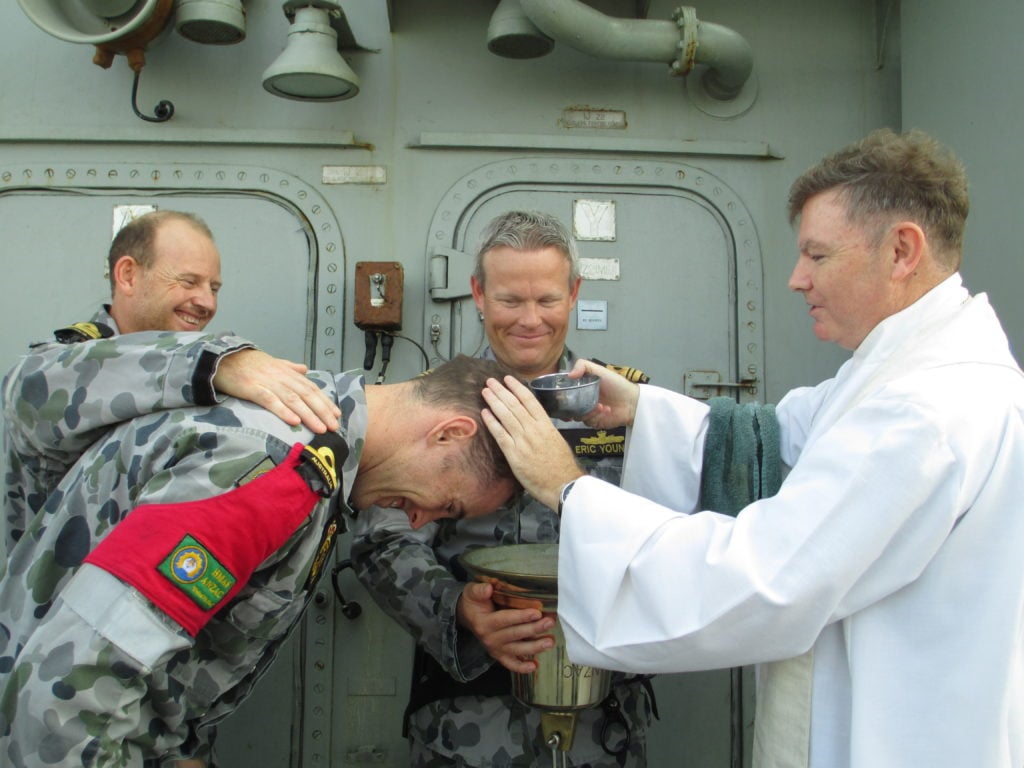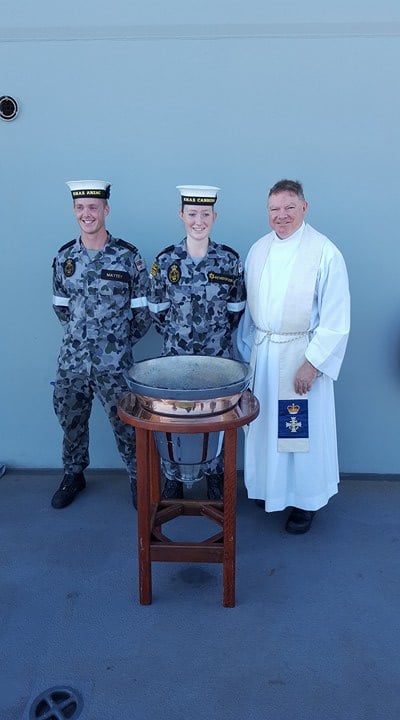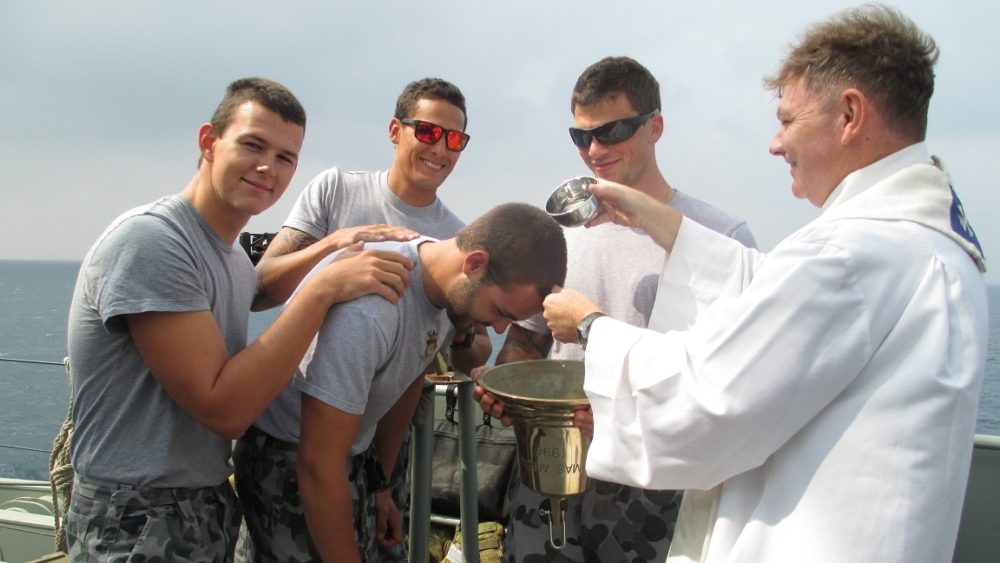Being a Navy chaplain comes with its own fascinating traditions. One of these, as Eternity discovered, is the practice of using the ship’s bell for baptisms.
Eternity met Senior Chaplain Paul Stuart aboard the HMAS Canberra III in October, when Bible Society Australia launched a new ‘Navy Bible’ with an updated camouflage cover.
This gently spoken Catholic priest – or “Padre” as he is known – provides pastoral support for 480 people when the ship is docked in harbour, and up to 1200 when they are deployed at sea.
Stuart shared with Eternity that his door was always open to any of the men and women under his care, to discuss matters of relationships, personal concerns, work conflicts, bereavement and spirituality. This type of work, he said, amounted to nine-tenths of the job.
The other one tenth consists of ceremonial work, including the joyful ritual of conducting baptisms in the ship’s bell. And, of course we just had to go back to Stuart to learn more.
Where did the tradition of baptising people in a ship’s bell come from?
This tradition began in the [British] Royal Navy, but the exact date of the first one is unknown. It has been continued in the Navies of the Commonwealth, such as Australia, [and also in] the United States. The child or adult baptised has their name and date of baptism engraved in the lip of the bell.
Who gets baptised in a ship’s bell?
In my 15 years as a Navy Chaplain, about 80 per cent of those I’ve baptised from the Navy community are babies or children of sailors and soldiers. About 20 per cent are adults, all of whom are sailors or Navy Officers who have different reasons for wanting to be baptised as a Christian.
About half of the adult baptisms are of those who have been aware that they were not baptised as infants and have wanted to identify as Christian for some time. But the opportunity [to do so] only presented itself when their ship acquired a chaplain, and conversations with “the padre” and/or attending church services or Bible studies led to a formal request.
I recall a good number of sailor and officer baptisms came about during very long overseas deployments to the Middle East with lots of time for those deployed to think about the “big questions of life”: Why are we here? Is there life after death? Does God exist? Which “god” is the true God? Who and what is Jesus? Are the Bible stories and teachings true or valuable?

Who is present at a baptismal service and what role do they play?
Different Christian denominations have different ceremony requirements, liturgies, rites and traditions. The one I belong to requires a “Godparent” (or two) for a child, or an adult “sponsor” for an adult who is baptised.
The role of Godparent is someone who is a committed Christian who promises to ensure the child, if anything happens to their parents, receives a Christian upbringing. Some cultures expand this role of Godparent to include being a major moral and protective influence over the child as they grow into adulthood.
The adult sponsor is someone similar – a committed Christian who supports the one baptised in their choice to be a Christian. I like to refer to the sponsor as a “God brother” or “God sister.”
Ceremonially, the sponsor places their right hand on the right shoulder of the one being baptised, as the chaplain pours water over the head of the baptised, saying the words Jesus commanded: “I baptise you in the name of the Father, and of the Son and of the Holy Spirit”.
There are, and can be, other symbols used: anointing with holy oil; lighting of a candle representing Jesus as our light in this world guiding us in the darkness; wearing of a white garment, as Saint Paul teaches to “put on Christ like you put on clothes”.
What’s the mood like? Is it quite solemn and formal, or more celebratory?
This depends on the personalities gathered. I do know some sailors have “teased” a fellow sailor for wanting to be baptised … But those gathered are generally supportive of, and happy for, their shipmate who is going through this sacred ritual and are respectful of the ceremony’s meaning. Some have cried with emotion and joy. Some are matter-of-fact about it all.
Obviously, a grown man or woman can’t be fully immersed in a bell – is that the norm for baptismal tradition?
I have conducted full-immersion baptisms and the “less wet” pouring-of-water-over-the-head-from-a-cup style. The tradition of being baptised in a ship’s bell really restricts the action to pouring water over the baptised person’s head and not full immersion. However, Navy chaplains have conducted full-immersion baptisms of sailors in rivers (for example, the River Jordan when a ship’s crew were in the Middle East).
How is the bell used when it is not being used for baptisms?
The bell hangs in a certain location and bears the name of the ship and the year it was commissioned. It is rung at 8am (forenoon watch) and at sunset in naval ceremonies that include raising and lowering of the Australian White Ensign and the Australian National Flag – at either ends of the ship.
Those in attendance salute after the boatswain’s call (whistle or pipe), which is sounded after the ringing of the bell for a set number of peals.

How do you feel about this part of your job?
A Navy baptism on a ship or in a chapel ashore is a great joy to me. I average just over a dozen a year, which is much less than a typical civilian parish or church but, nevertheless, is still meaningful and wonderful.
I am also aware of the visitors’ (family and friends) awe of being on a warship, usually for the first time.
The baptism of a sailor comes at the end of religious instruction and preparation and, so, it is not just the ritual itself but also the journeying in faith with the person to be baptised and being uplifted by their commitment to Christ and Christianity.
Email This Story
Why not send this to a friend?




